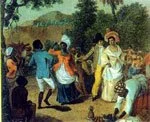 Barbados is the eastern-most Caribbean island. It is located at 13.4N, 54.4W.The first indigenous people were Amerindians who arrived here from Venezuela. Paddling long dugout canoes they crossed oceans and currents that challenge modern sailing vessels.
Barbados is the eastern-most Caribbean island. It is located at 13.4N, 54.4W.The first indigenous people were Amerindians who arrived here from Venezuela. Paddling long dugout canoes they crossed oceans and currents that challenge modern sailing vessels.
They made their new home in Barbados along the coast, leaving behind hardly a trace, only a hint of evidence for the archaeologist to date. Fragments of tools made of shell, utensils, refuse and burial places convey but a mystery of their time.
The Arawaks were short, olive-skinned people who bound their foreheads during infancy to slope it into a point. (Book: History of Barbados). They were an agricultural people and grew cotton, cassava, corn, peanuts, guavas, and papaws (papaya). The Arawaks also used harpoons, nets, and hooks, to fish for food (History of Barbados).
In 1200, the Arawaks were believed to be conquered by the Caribs. The Caribs were a taller and stronger Amerindian tribe than the Arawaks. They were also believed to be cannibals. They were incredibly accurate bowmen and used a powerful poison to paralyze their prey. (History of Barbados).
The Portugese came to Barbados en route to Brazil. It was at this time that the island was named Los Barbados (bearded-ones) by the Portugese explorer Pedro a Campos. It was so named, presumably, after the island's fig trees, which have a beard-like appearance.
The first English came to the island on May 14th 1625 under the command of Captain John Powell. The island was therefore claimed on behalf of King James I.
On February 17th 1627, Captain Henry Powell landed with a party of 80 settlers and 10 slaves to occupy and settle the island. This expedition landed in Holetown formerly known as Jamestown. The colonists established a House of Assembly in 1639. It was the 3rd ever Parliamentary Democracy in the world (Barbados History).
People with good financial backgrounds and social connections with England were allocated land. Within a few years much of the land had been deforested to make way for tobacco and cotton plantations.
During the 1630s, sugar cane was introduced to the agriculture. A potential market formed for slaves and sugar-making machinery by the Dutch Merchants who were to supply Barbados with their requirements of forced labour from West Africa. The slaves came from Sierra Leone, Guinea, Ghana, the Ivory Coast, Nigeria and Cameroon. Many slaves did not survive the journey from Africa, but many thousands still reached their destination.
The Barbadians dominated the Caribbean Sugar Industry in these early years. The sugar plantation owners were powerful and successful businessmen who had arrived in Barbados in the early years.
By 1720 Barbadians were no longer a dominant force within the sugar industry. They had been surpassed by the Leeward Islands and Jamaica.
1807 - 1838 . Abolition, rebellion and emancipation
After slavery was abolished in 1834, many of the new citizens of Barbados took advantage of the superb education available on the island. After these citizens had been educated, they wanted something more than working in the cane fields. Some of them gained prominent offices in Barbados. Others worked in common jobs, and still others stayed in the cane fields (Barbados History).